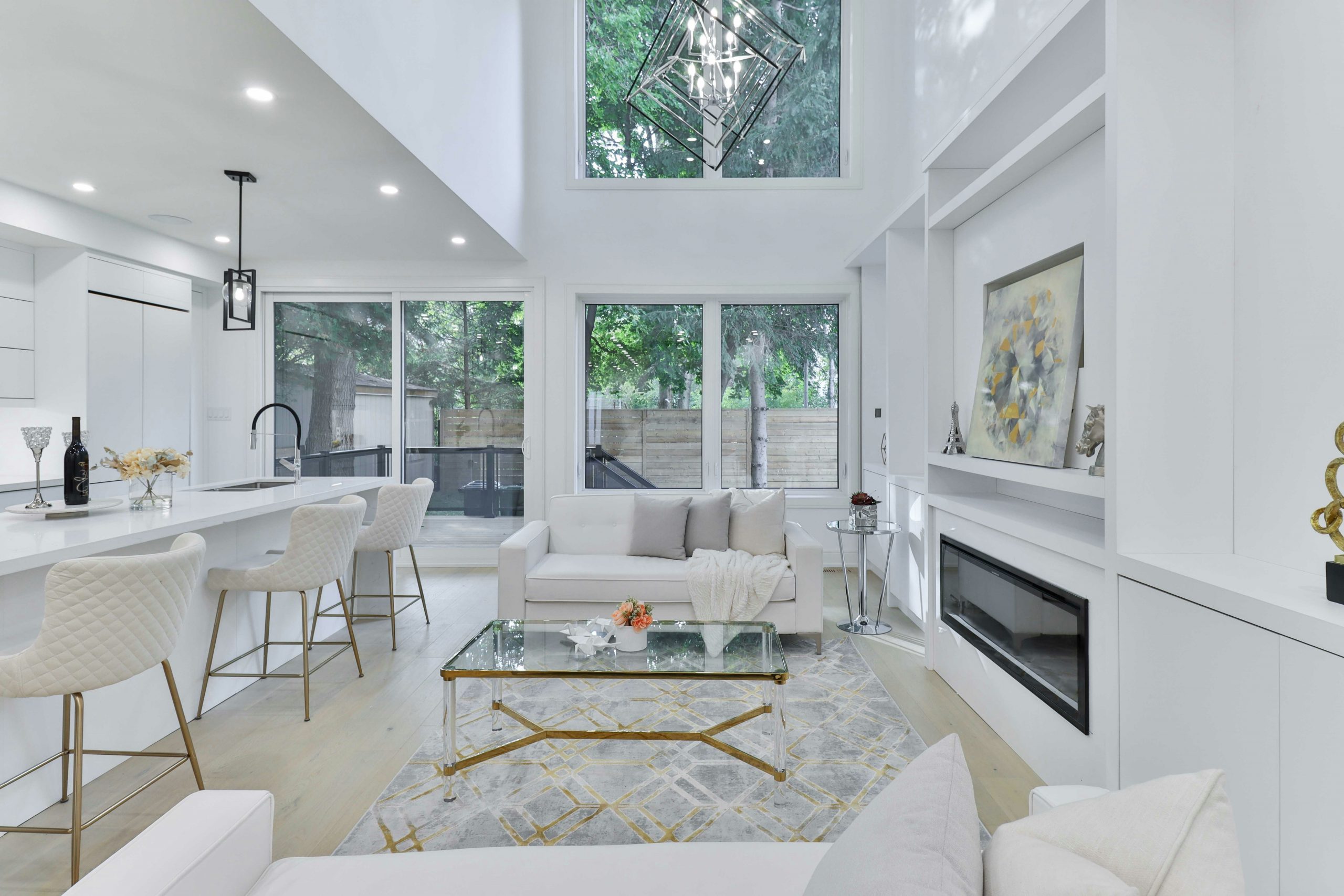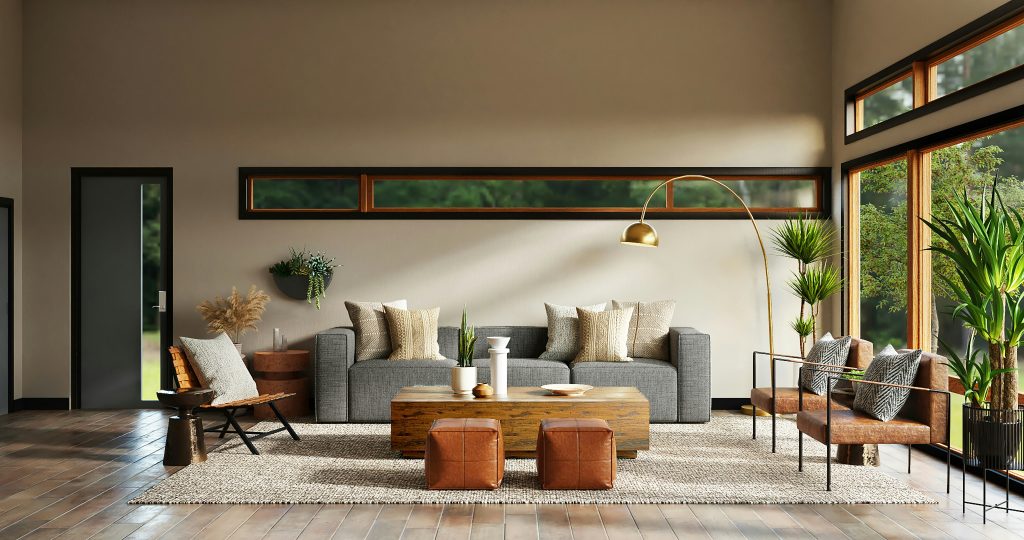Advice and Insight in Bite-Sized Chunks: A Guide to Home Staging
- What is Home Staging?
- Where Did Home Staging Originate?
- How Exactly Does Home Staging Work?
- Why Does Home Staging Work So Well?
- What Types of Home Staging Exist?
- What Makes Good Home Staging?
- In Which Cases is Home Staging Worthwhile?
- Are There Scientific Studies on the Effectiveness of Home Staging?
- How Much Does Professional Home Staging Cost?
- Who Bears the Costs for Home Staging?
- Can I Deduct the Costs of Home Staging from Taxes?
- Can I Do Home Staging Myself or Should I Hire a Professional?
- Home Staging by the Swiss Property Owners Association
- Home Staging from A to Z
What is Home Staging?
Home staging—unfortunately, there is no equivalent term in German—refers to all measures taken to enhance the interior and exterior spaces of a property for sale. A professional home staging company creates a coordinated concept of furniture, accessories, colors, and lighting, and provides recommendations for any minor renovation work that may be necessary, such as repairs and painting.
The objective of home staging is to present a property for sale in the most favorable light possible, thereby achieving a shorter marketing period and a higher selling price. In most cases, the additional revenue significantly exceeds the costs of home staging.
Where Did Home Staging Originate?
Home staging originated in the United States in the 1970s and has long been established in many English-speaking countries for marketing properties.
With a few decades of delay and still very tentatively, home staging has increasingly been used in Switzerland in recent years. The Swiss Property Owners Association sees itself in a pioneering role here and implements home staging whenever possible and sensible in property marketing. Many real estate agents and private property sellers shy away from the high initial costs of this marketing measure and fail to see that the expenditures for intelligently applied home staging more than pay off in most cases through shorter marketing times and higher sale prices.
Regarding costs: All members of the Swiss Property Owners Association benefit from significantly reduced costs or even complete cost coverage for home staging within a sales mandate.
How Exactly Does Home Staging Work?
Home staging makes a property attractive to potential buyers through targeted decoration and furnishing, often creating a positive first impression during viewings. By designing the rooms appealingly and professionally, emotions are evoked, and prospective homeowners can better visualize the room proportions. Ideally, a sense of comfort is established right from the start, making prospects fall in love with their new home and converting them into buyers.
Professionals typically proceed as follows:
- Inspection and Consultation: Home stagers often first want to assess the condition of the property on-site. This allows them to gauge how extensive the marketing measures should be and discuss this with the sellers.
- Preliminary Work: Once an appropriate home staging solution has been agreed upon, the next step is to declutter the house, depersonalize it, eliminate any disorder, and touch up minor wear and tear. If necessary, walls may be repainted or preliminary work done in the garden or exterior areas.
- Conceptualization: Next, home stagers design a coherent furnishing, space, color, and lighting concept tailored to the characteristics of the property and enhancing its value. Special attention is given to the selection of furniture—it should ideally be high-quality and neutral. From our experience, furniture from the agency’s own inventory is preferable to cheap alternatives like cardboard furniture (cheap usually looks cheap).
- Implementation: In the final step, the apartment or house is staged; furniture is delivered and the property decorated.
The scope of home staging measures naturally depends on the available budget. It is advisable to apply a consistent staging concept and stage all rooms. Staging only individual rooms and presenting them in the best possible light can be counterproductive, as it may accentuate the contrast to the vacant or unstaged rooms.
Why Does Home Staging Work So Well?
Home staging is essentially applied psychology and takes advantage of the following common behaviors of potential buyers:
- First Impression: People quickly form an opinion about a property based on their first impression. Home staging aims to create a positive first impression by making the property attractive and inviting.
- Emotional Connection: Home staging attempts to establish an emotional connection between potential buyers and the property. Through skillful staging, positive emotions such as joy, security, and satisfaction are evoked—creating a feel-good effect. This can lead potential buyers to develop a connection with the property and envision themselves living there.
- Neutrality and Depersonalization: It is often recommended to remove personal items and individual decorations during home staging to appeal to a broader audience. This allows prospects to better imagine how they might design and use the space themselves.
- Perception of Space: The way rooms are arranged can influence perceptions of size, function, and usability. Home staging professionals use psychological principles to make spaces appear larger, brighter, and more open. Through strategic placement of furniture, use of light and colors, and organization of space, optimal room perception is created.
- Trust Building: Home staging can also help build trust with potential buyers. By professionally presenting the property, the impression is conveyed that the house is well-maintained and in good condition. This can eliminate initial uncertainties and doubts, encouraging potential buyers to show further interest.
Another psychological advantage: A furnished apartment or staged house looks move-in ready, and potential buyers do not immediately see the considerable effort that comes after the purchase. This effect is confirmed by various studies and surveys from the USA.
Important: Home staging is not intended to disadvantage buyers. On the contrary, home staging reveals potential that buyers might not recognize without it—thus they might not purchase their dream property.
What Types of Home Staging Are There?
Depending on the situation and budget, there are many different ways to stage a property. We have navigated through the terminology jungle and tried to create an overview:
Full Home Staging: An empty property is fully staged, meaning it is furnished and decorated. Depending on the provider, you can also choose a suitable lighting or scent concept to maximize the property’s potential.
Partial Home Staging: Either specific rooms of an apartment or house are targeted for staging to put them in the best possible light, or the home staging includes only certain components (furnishing, decoration, repairing wear and tear, etc.).
Complementary Home Staging: If a property is still partially furnished, home staging can enhance its appearance and create a professional impression. By strategically placing certain pieces of furniture, the property’s value is enhanced.
Home Staging Light: Here, the credo “use what you have” applies—a professional helps to depersonalize the rooms to achieve the desired “hotel effect.”
Virtual Home Staging: This is the most cost-effective option—furnishings are placed in a photo to help one imagine how the empty space could be furnished. However, experience shows that virtual home staging cannot replace an on-site visit. Ultimately, emotions play a decisive role in buying a home; one needs to feel at home on-site, not just in front of a screen.
What Makes Good Home Staging?
In home staging, there are several key points to consider:
Neutrality: Use neutral colors and decorations to appeal to the tastes of a broad audience. A well-thought-out style concept is also relevant.
Decluttering/Depersonalization: For properties that are still inhabited, remove personal items and unnecessary furniture to convey a clean and spacious impression.
Lighting: A well-considered lighting concept that mixes natural and artificial light to make the space bright and inviting.
Highlighting Features: Consciously emphasize the best features of the house or apartment, such as architectural details or special amenities.
Attention to Small Details: Fresh flowers and stylish accessories help to enhance the overall impression.
Outdoor Area: A welcoming entrance and a well-maintained garden or terrace create an inviting atmosphere.
It’s important to create a homely ambiance in which a wide range of people can feel comfortable. Through professional color selection and the right choice of furniture, accessories, and art objects, a thoughtful design concept is created. This should make it as easy as possible for prospects to imagine their future in the property. A study by the National Association of REALTORS (NAR) found that 77% of buyers surveyed could better imagine a professionally furnished home as their future residence compared to an empty property.
Advantages and Disadvantages of Home Staging
Advantages:
- Shorter Marketing Time: Leads to lower marketing costs (e.g., advertising expenses) and holding costs for vacancies (e.g., mortgage interest and utilities).
- Higher Selling Price
- Competitive Edge: Home staging helps differentiate your property positively from other listings.
- More Viewings: Potential buyers are more likely to visit staged properties.
Disadvantages:
- Initial Costs: Good home staging can cost CHF 10,000 or more. However, in most cases, the positive effects of home staging more than offset the costs.
When is Home Staging Worth It?
Home staging is almost always worthwhile in Switzerland—regardless of the type of property or market conditions—and whether the property is vacant or still inhabited. Clearly, home staging is a proven and effective method to enhance the sales value, attract more potential buyers, and speed up the sales process.
Numerous studies and statistics confirm that home staging is successful and the costs of home staging measures are quickly amortized through a higher selling price. In short: it is a worthwhile investment, whether for a simple apartment or a luxurious villa.
Are There Scientific Studies on the Effectiveness of Home Staging?
Especially in the USA, there are various studies and surveys that provide empirical evidence regarding the effectiveness of home staging. For instance, a 2017 study by the National Association of Realtors (NAR) showed that staging an apartment offers a measurable sales advantage, typically achieving a higher selling price. According to the NAR, about one-third of realtors say that staging offers lead to purchase offers that are 1% to 5% higher than similar unstaged properties. Another 21% of realtors noted that the value of a home increased by 6% to 10% due to staging.
According to another study from an American industry association, there is also a demonstrable effect on the duration on the market. Professionally staged properties typically sell faster. According to the NAR, 62% of realtors said that staging positively affects the marketing time of a house. The Real Estate Staging Association (RESA) also found in a 2020 study that “staged” houses enjoy significantly higher demand, sell faster, and the achieved selling price was between 5% and 23% higher than the originally set selling price in 85% of the cases.
Not only the Anglo-Saxon world is enthusiastic about home staging. In Sweden, several studies have shown that properties can be sold both quicker and for up to 15% higher prices. Interestingly, despite the apparent advantages, home staging is not yet widespread in Switzerland.
How Much Does Professional Home Staging Cost?
The costs for professional home staging depend on various factors such as the living area of the property and the scope of the project. A professionally conducted “Full Home Staging” can quickly cost more than CHF 10,000. Common but risky are agreements where the initial price includes the first 8 weeks, but each additional week incurs further costs. Depending on the duration of marketing, it can become expensive.
Who Bears the Costs for Home Staging?
Normally, the seller must cover the costs of home staging. Generally, this investment pays off, and the associated costs of home staging measures are quickly amortized through a higher selling price.
At the Swiss Property Owners Association, we are so convinced of the effectiveness of home staging that we pre-finance the costs for our members under a sales mandate and, in some cases, even cover them entirely. Depending on the scope of the required work, we also help with painting or advance smaller renovation works.
Can I Deduct the Costs of Home Staging from Taxes?
Since home staging is still relatively young and not widely spread in Switzerland, there are no uniform guidelines for tax deductibility. The Swiss Property Owners Association maintains that home staging is a marketing measure and therefore can be deducted as selling costs for calculating the property gain tax. Additionally, home staging increases the selling price and thus the property gain tax—it would only be logical if the measures that led to a higher property gain tax could be deducted as an expense.
Can I Do Home Staging Myself or Should I Hire a Professional?
Showcasing a property in the best light requires time, experience, and especially expertise. A professional home stager knows exactly how to stage the specific features of a single-family home or the characteristic architecture of a city apartment to fully capitalize on the property’s potential. There are even courses taught on setting the right accents and highlighting relevant features to attract potential buyers.
If one is not deterred by the effort, a “Do-It-Yourself” approach is certainly feasible. Often, however, the necessary furniture pieces and decorative items are lacking; fundamentally, the business model of home stagers is based on renting furniture pieces. Adventurous DIY attempts at home staging should thus be well-considered. Even if one has a trained eye and a flair for tasteful decoration, an objective professional’s perspective helps streamline the sales process, avoid pitfalls, and achieve the best possible selling price on the market.
Home Staging by the Swiss Property Owners Association
For our association members, we offer home staging services in collaboration with our partner company tRaumplaner, either free of charge or at a significantly reduced rate within the framework of a sales mandate. We are happy to help you maximize the potential and sale price of your property.
Home Staging from A to Z
A – Aesthetics Aesthetics are central to home staging. The goal is to design the property in a way that appeals to potential buyers and increases its value.
B – Budget The budget for home staging can vary. In Switzerland, it can range from a few hundred to several thousand francs, depending on the size of the property and the desired service level.
C – Character The character of the property should not be lost during staging but ideally highlighted to build an emotional connection with potential buyers.
D – Decoration Decorative elements such as pictures, plants, and cushions are used to make rooms more inviting and appealing.
E – Decluttering Before staging begins, it is often necessary to declutter the property and remove personal items.
F – Photography High-quality photographs are important to present the staged home in the best light, especially for online listings.
G – Floor Plan A clear, logical floor plan helps potential buyers navigate the property and make optimal use of the space.
H – Home Staging Agencies In Switzerland, there are specialized agencies that can handle the entire home staging process.
I – Investment Home staging is an investment that often pays off through a faster sale and a higher selling price.
J – Young and Old Home staging should appeal to a variety of target groups, both young and older buyers.
K – Kitchen The kitchen is a key focus in home staging, as it is often considered the “heart of the home.”
L – Lighting Good lighting can significantly influence the mood of a property and make it more inviting.
M – Furniture Furniture should be well-proportioned and ensure that the room neither feels overcrowded nor too empty.
N – Sustainability There is a trend toward using sustainable materials and furniture, which is often well received in environmentally conscious Switzerland.
O – Online Presence A strong online presence with photos and descriptions of the staged home is crucial for sales success.
P – Professionalism Professionalism in execution and customer relations is essential for successful home staging.
Q – Quality The quality of home staging can be decisive for the first impression a potential buyer gets of the property.
R – Room Layout The room layout should be logical and meet the needs of the target audience.
S – Style The style of home staging should match the property but also be flexible enough to appeal to a broad audience.
T – Trends Interior design trends can be considered, but they should not overshadow the timeless elements of the home.
U – Moving Home staging is often done before moving out to make the property ready for sale.
V – Sale Price Professional home staging can often lead to a higher sale price.
W – Living Room The living room is often the focal point of a property and should be particularly well-designed.
X – X-Factor The so-called X-Factor is the special something that distinguishes a property and sets it apart from others.
Y – Yard (Garden) In Switzerland, the outdoor area is often as important as the indoor area. A well-maintained garden can increase the value of a property.
Z – Time Professional home staging can accelerate the sales process by presenting the property as more attractive and ready for sale.



